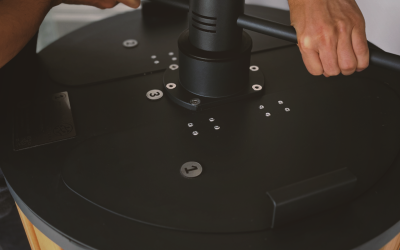Turning organic waste into natural fertiliser is an environmentally friendly practice that is becoming increasingly popular among households looking to reduce their environmental impact. Among the most effective devices for accelerating the decomposition of biodegradable waste, the rotating composter stands out for its innovative mechanism that optimises the transformation of materials. Its structure, designed to facilitate aeration and homogenise the fermentation of waste, is available in different materials, each with specific characteristics. The choice of coating plays a key role in the device’s durability, thermal efficiency and ability to withstand outdoor conditions. Selecting the most suitable material ensures optimal degradation of bio-waste while guaranteeing long-lasting and efficient use of the recycling system.
Why does the material influence the efficiency of the rotating composter?
The rotating container for biodegradable waste degradation must be made of a material capable of maintaining a suitable temperature to promote the activity of the microorganisms responsible for transforming organic matter. Good thermal insulation helps to retain the heat generated by fermentation, thereby accelerating the maturation of the substrate undergoing decomposition. The robustness of the coating is also essential to prevent cracks or premature degradation due to climatic variations. A material that is too light or fragile may deteriorate under the effects of the weather, which can affect the longevity of the device. Resistance to impact, UV rays and temperature variations is therefore a fundamental criterion in the choice of material to ensure a high-performance biowaste recycler over the long term.
Why choose a rotating composter made from recycled plastic?
Recycled plastic is a material frequently used in the manufacture of rotating composters due to its light weight, affordability and weather resistance. Its ability to retain heat helps maintain a stable internal temperature, optimising the decomposition rate of food and plant waste. The main advantage of this material is that it does not rust and is easy to maintain. Its waterproof properties limit the infiltration of external moisture, which prevents excess water from slowing down the fermentation of organic waste. In addition, its rot-proof nature prevents the growth of mould or unwanted bacteria on the walls of the fermentation bin. However, a plastic rotary composter must be of good quality to prevent premature wear due to UV rays or temperature variations. Opting for a model made of high-density polyethylene (HDPE) guarantees better durability and increased resistance to external stresses.
What are the advantages of a metal rotary composter?
A rotating container made of galvanised steel or aluminium stands out for its robustness and durability. This type of structure is particularly suitable for environments subject to harsh weather conditions, as metal does not deform under the effect of heat and withstands temperature fluctuations better than plastic. Its main advantage is its ability to absorb and release heat efficiently, which speeds up the fermentation process of biowaste. In addition, a metal composter offers optimal protection against pests, especially rodents, which may try to access the decomposing waste. However, this material has some drawbacks, including its heavier weight, which can make the device more difficult to move. Furthermore, although galvanised steel is treated against corrosion, some lower-quality models may be susceptible to moisture and require regular maintenance to prevent rusting.
Why choose a wooden rotating composter?
A rotating wooden bin is an attractive and environmentally friendly alternative that blends perfectly into any garden while providing natural thermal insulation. This material has the advantage of being biodegradable and renewable, making it an ideal choice for those who prioritise sustainable solutions. Wood retains heat inside the container, promoting efficient decomposition of organic waste. Some models are made from autoclave-treated wood or red cedar, which are known for their resistance to moisture and insects. However, despite its ecological appeal, a wooden composter requires regular maintenance to prevent it from deteriorating due to weather conditions. It is recommended to apply a protective oil or water-repellent treatment to extend its life and prevent mould growth. Its heavier weight can also be a disadvantage, although this does ensure greater stability.
Which material should you choose to maximise the durability and efficiency of your rotating composter?
The choice of material for a rotary recycling system depends primarily on the conditions of use and expectations in terms of durability and performance. For urban use, a recycled plastic composter is a practical and easy-to-maintain solution, suitable for small spaces such as balconies or small terraces. However, for a garden exposed to climatic variations, a metal model offers superior strength and better protection against pests. Those looking for a more environmentally friendly and aesthetic approach may prefer wood, taking care to protect it from moisture and insects.
A well-chosen rotating container ensures an efficient fermentation process and facilitates the daily management of bio-waste. Its material plays a key role in the thermal insulation, weather resistance and durability of the device. Opting for a robust model that is suited to its environment optimises the transformation of organic waste into a high-quality natural fertiliser while reducing the environmental impact. Whether you prefer plastic, metal or wood, the important thing is to select a composter that meets your specific needs in terms of capacity, maintenance and efficiency. Effective recycling of biodegradable waste depends not only on a good balance of materials, but also on suitable equipment that guarantees optimal fermentation conditions.

